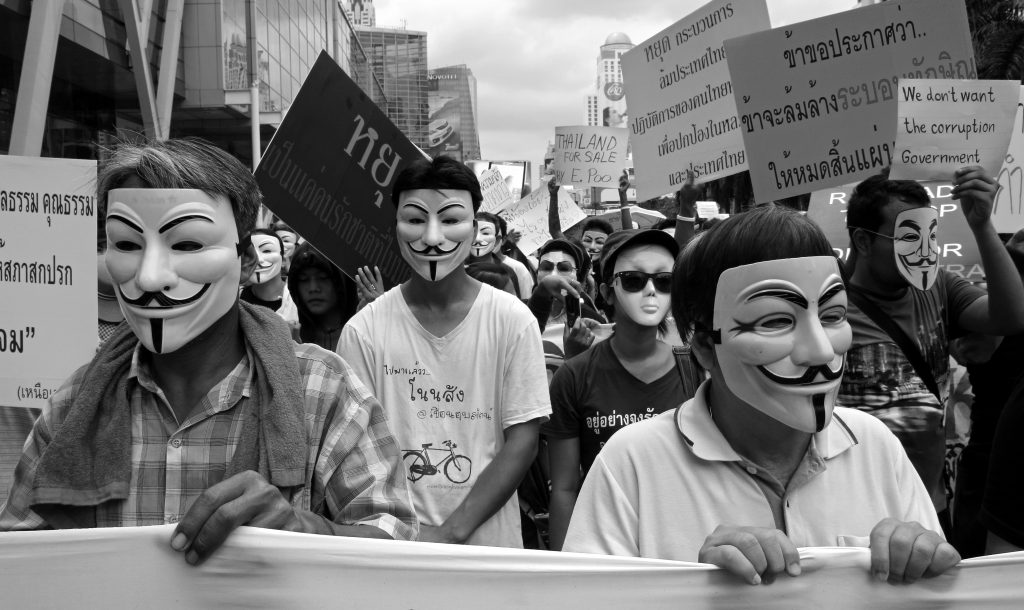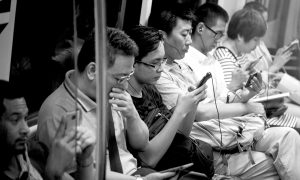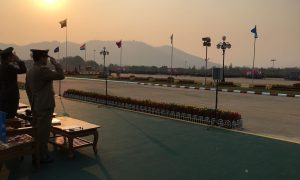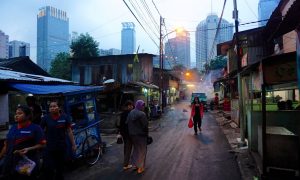In the mid-1990s, there was a lot of enthusiasm for non-governmental organisations (NGOs) and the expansion of civil society in Southeast Asia. At the time, there was an efflorescence of activism as activists campaigned against trade agreements, foregrounded gender issues, worked to reduce poverty, improve health, protect the environment, advocated for workers and consumers, exposed corruption, bolstered human rights and agitated for democracy.
The optimism of the decade was driven by a feeling of confidence that democracy was taking root in the region, growing on a foundation of thriving capitalist economies. The resonance of 1960s modernisation theory was palpable—the “Third Wave” of democratisation was said to be washing over the region. This was emphasised by the triumphs of popular uprisings in the Philippines (1986), South Korea (1987), Thailand (1992) and Indonesia (1998). These events were associated in the theory with the rise of the middle class and an expansion of civil society.
Two decades later, this optimism has faded. There is now more pessimism about civil society and democratisation. To understand these changing perspectives, it is necessary to give attention to recent political events, and rethink how we conceptualise civil society and its role in Southeast Asian politics today.
Civil society and democratisation
The notion of “civil society” has meanings embedded in the development of capitalism and the end of absolutism in Europe, and the consequent reduction of the weight of the state. The idea of a space relatively autonomous of the state developed quite late in colonial and postcolonial Southeast Asia. While anticolonial, socialist and communist movements, religious and educational organisations, trade unions and the like were established from the late 19th century, they were usually repressed.
When writing of civil society in late 20th century Southeast Asia, analysts tended to emphasise the non-state nature of civil society organisations (CSOs). Many have agreed with David Steinberg, who defined civil society as:
composed of those non-ephemeral organizations of individuals banded together for a common purpose or purposes to pursue those interests through group activities and by peaceful means. These are generally non-profit organizations, and may be local or national, advocacy or supportive, religious, cultural, social, professional, educational, or even organizations that, while not for profit, support the business sector, such as chambers of commerce, trade associations, etc.
The organisations mentioned can be formal or informal, may be charitable, developmental or political. Yet when considering democratisation, authors usually associate civil society with efforts to expand political space. Some authors identify a “political civil society,” where “non-violent … organisations and movements … seek to promote human rights and democratisation…”. Their efforts mean that the political space of civil society becomes a site of intense competition and struggle—including for the organisations that occupy this space.
Civil society and political conflict
But this conceptualisation of civil society—one which views the groups making up civil society as only being non-violent and peaceful—is too limiting. Civil society and its political space is open to many groups, not just those considered “democratic” and “progressive”. That space can also be occupied by state-sponsored, right-wing, anti-immigrant and anti-democracy activists, and many others considered nasty, fascist, and reactionary. That the groups occupying civil society’s political space will sometimes be violent, and will oppose other groups, should be no surprise when we consider that all societies are riven and driven by conflict over all manner of resources.
Thinking this way of political space and civil society is not uncontroversial. Much of conventional political science, heavily imbued with modernisation theory, has romanticised civil society as the natural domain of individual and group freedoms, and sometimes conceived of NGOs and CSOs as representative interest groups. Such a perspective treats conflict and division as pathological, and misses the fact that political space is created through contestation with the state and with other groups in society. It is a view that fails to give sufficient attention to how civil society groups have actually behaved.
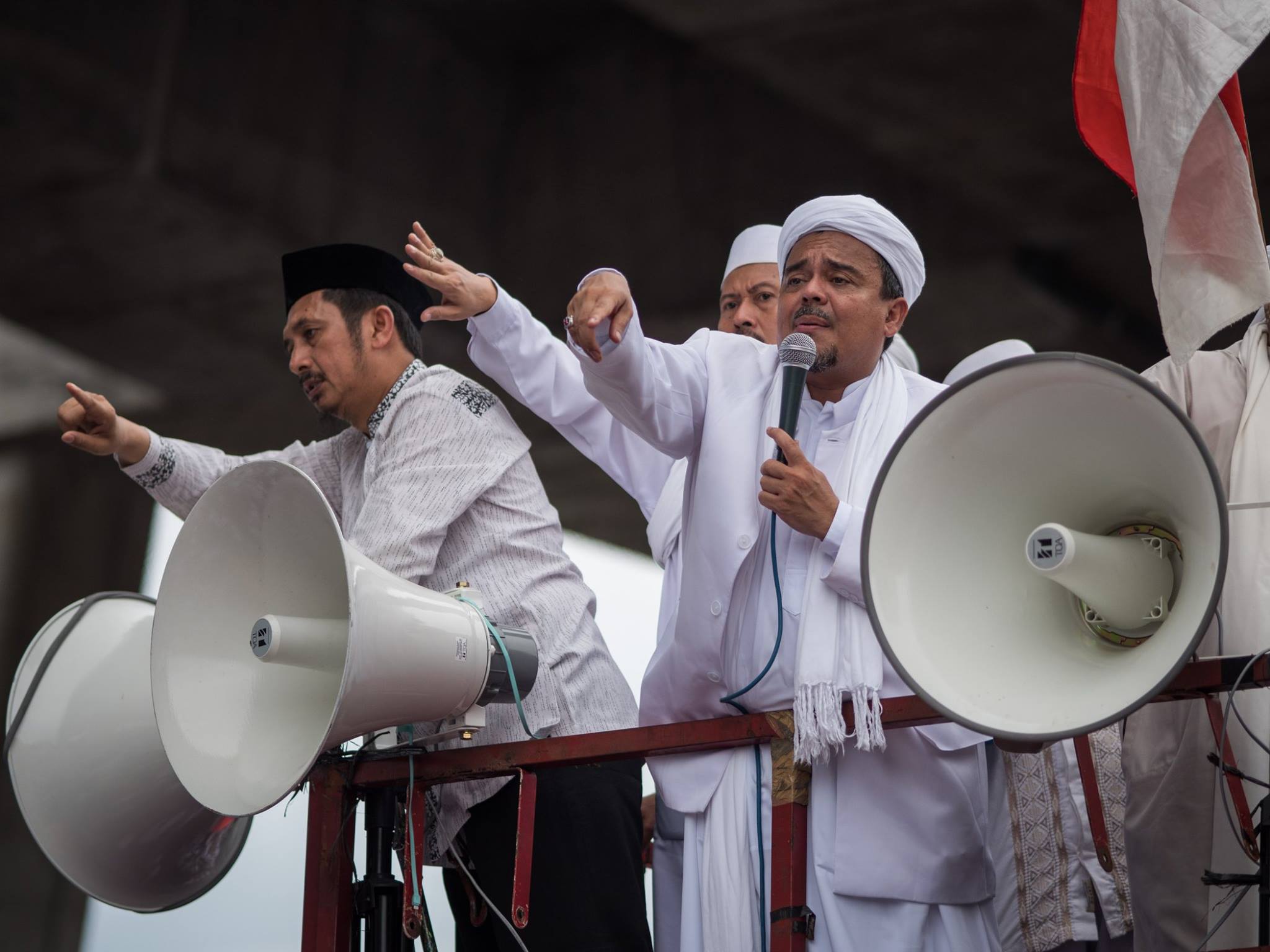
The now-exiled Islamic Defenders Front (FPI) leader Rizieq Shihab at a January 2017 protest against former Jakarta governor Basuki Tjahaja Purnama. Photo: Ray Yen
Contestation within civil society
When we think of civil society as a site of struggle, it becomes clear that it is not always a ballast for democratisation. Islamic militias in Indonesia, racist Buddhist gangs in Myanmar and right-wing ultranationalists in the Philippines and Thailand are not forces for a democratic society—yet each undoubtedly occupies the space of civil society.
Islamic militias have re-emerged at various times during Indonesia’s reformasi era and engaged in mobilisation and violence. While the use of violence might exclude such groups from the romanticised approaches to civil society, militias have occupied a space created by democratisation, even if their activities are meant to mobilise anti-democratic groups and against some freedoms. A recent example of such anti-democratic opposition was seen in the defeat of Basuki Tjahaja Purnama (Ahok) in the 2017 Jakarta governor’s election. The Islamic Defenders Front (Front Pembela Islam, or FPI) joined with several political parties to oppose Ahok in an acrimonious contest that involved the mobilisation of Islamic identity in huge demonstrations that targeted Ahok as a Chinese Christian portrayed as “threatening” Islam. Eventually, Ahok’s opponents gained the support of elements of the state to jail him on charges of blasphemy and inciting violence.
In Myanmar, religious groups have also engaged in racist and xenophobic activism. Radical Buddhists such as the ultra-nationalist 969 Movement and Ma Ba Tha (Myanmar Patriotic Association) have been able to mobilise mass demonstrations against Muslims and have fuelled extreme communal violence since 2012. Such groups have also been supported by elements of the state and by elected politicians, all the while taking advantage of the expanded political space created by Myanmar’s political transition to mobilise and propagandise.
Indonesia and Myanmar demonstrate how extremists use the political space of civil society, and elements of electoral democracy, to oppose and challenge the freedoms that have come with democratisation. These groups are connected with some of the most regressive elements that continue to populate some state agencies. So far, they have not managed to destroy the political basis of these new democracies. But to see how the political space of civil society was used to re-establish authoritarianism in a Southeast Asian “democratic success story” of years past, we only need to turn our eyes to Thailand’s decade of high-octane political contestation.
Thailand: civil society for military dictatorship
Thailand’s recent political mobilisations have been designated by the colours that define their motivations. Their massive street demonstrations mobilised many, including NGOs and CSOs. The broad Red Shirt movement and the official United Front for Democracy against Dictatorship bring together supporters of electoral politics, those opposed to military interventions, and supporters of Thaksin Shinawatra. The Red Shirts, of course, developed to oppose the anti-Thaksin Yellow Shirt movement. The latter initially coagulated as the People’s Alliance for Democracy (PAD), wearing yellow to announce their royalism. Yellow Shirts tend to support the status quo, are anti-democratic, ultranationalist, and supported the 2006 and 2014 military coups.
In the 1990s, Thailand’s civil society, dominated by middle class interests, gained a reputation for opposing the military’s domination. NGOs and CSOs also tended to support the liberalising ideas that permeated the so-called People’s Constitution of 1997. When Thaksin was elected under the rules of this constitution in 2001, his government gained the support of many NGOs and CSOs. This support was forthcoming because of Thaksin’s initial nationalism, and his attention to grassroots issues and poverty eradication. That early support quickly drained away, with Thaksin coming to be viewed as authoritarian and corrupt.
The PAD, which was formed to oppose and bring down the popularly elected Thaksin, came to include many CSOs and NGOs which, at the time, would have been bundled into the broad category of “progressive civil society”. As the anti-Thaksin campaign expanded, the middle class, including spokespersons for civil society groups, began to denigrate the grassroots. The latter appreciated Thaksin’s “populist” policies and, especially in the north, northeast and central regions, voted for his parties in large numbers. Mobilised Yellow Shirts vilified this grassroots support for Thaksin, labelling those who voted for his party as ignorant, duped or bought.

Anti-Thaksin “Yellow shirts” protesting in Bangkok, November 2012. Photo: Nick Nostitz
As pro-Thaksin parties won every election from 2001 to 2011, the Yellow Shirts began an inevitable shift towards the denigration of the electoral processes itself, while declaring themselves the protectors of “true democracy”. The Yellow Shirts—the PAD and its clone, the People’s Democratic Reform Committee (PDRC)—emphatically rejected electoral politics, arguing that electoral victories amounted to a dictatorship of the majority. In the 2013–14, PDRC protesters opposed an election called by then prime minister Yingluck Shinawatra. Yellow Shirts blocked candidate registration, prevented the distribution of ballot papers, and tried to prevent voting on polling day. The PDRC argued that no election could be “free and fair” until the “Thaksin regime” had been destroyed. Their ultimatum was that the Yingluck government had to be thrown out, replaced by an appointed government and an appointed “reform” committee to purge those associated with Thaksin’s rule.
Backed by Bangkok’s middle class, including CSOs and NGOs, PAD and the PDRC campaigned for a “democracy” that rejected voting and elections. They wanted a greater reliance on selected and appointed “representatives”, usually opting for a royally- appointed government of “good” people. This paternalism was taken up by protesters, who claimed to champion transparency and anti-corruption while begging the military for a coup. Such Orwellian doublespeak was also in evidence when the military responded and seized power in 2014. The junta defined a coup and military dictatorship as a form of “democracy”. One pronouncement called on:
all Thai citizens [to] uphold and have faith in the democratic system with His Majesty the King as Head of State. [The] NCPO [junta] fully realizes that the military intervention may be perceived by the West as a threat to democracy and a violation of the people’s liberty. However, this military intervention was inevitable, in order to uphold national security and to strengthen democracy (emphasis added).
The result has been more than three years of military dictatorship that has narrowed political space and heavily restricted much civil society activism. Red Shirts had championed electoral politics, arguing that winning elections should count for something and reckoned that electoral democracy was the appropriate platform for political reform. Under the military junta, they have been demobilised, jailed, and repressed.
Interestingly, most of the PAD and PDRC-affiliated NGOS and CSOs have either supported, or at least not opposed, the junta. Some have continued to receive state funds. However, the relationship with the junta remains tense, not least because the junta sees some of these groups as contingent supporters, worrying about their capacity for mobilising supporters and considering them more anti-Thaksin than pro-junta. Few high-profile leaders of these groups have expressed regrets about having supported the 2006 and 2014 coups.
Complicating “civil society”
The travails of electoral democracy in Indonesia, Myanmar and Thailand are not unique in Southeast Asia. Certainly, any notion that increased national wealth results in a civil society that becomes a “natural” ballast of democratisation should be rejected. Democratisation does increase the space identified as civil society. However, this space is not always a stronghold of progressives. As a site of struggle, civil society can be occupied by groups that are anti-democratic, ultra-nationalist, and sectarian. As the experience of Thailand and other countries has made clear, much abstract talk of “civil society” runs the risk of crediting its constituent parts with a uniformly pro-democratic outlook that they manifestly do not hold.
• • • • • • • •

 Facebook
Facebook  Twitter
Twitter  Soundcloud
Soundcloud  Youtube
Youtube  Rss
Rss 